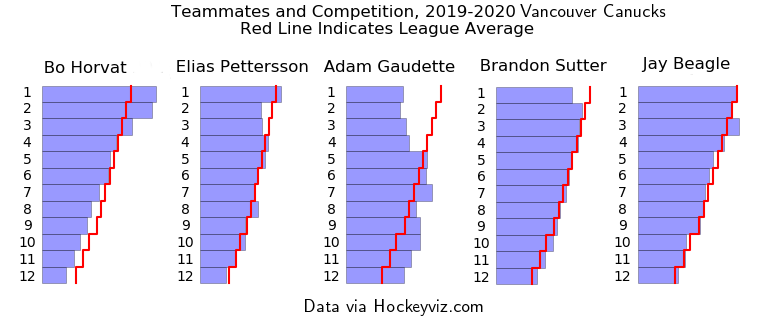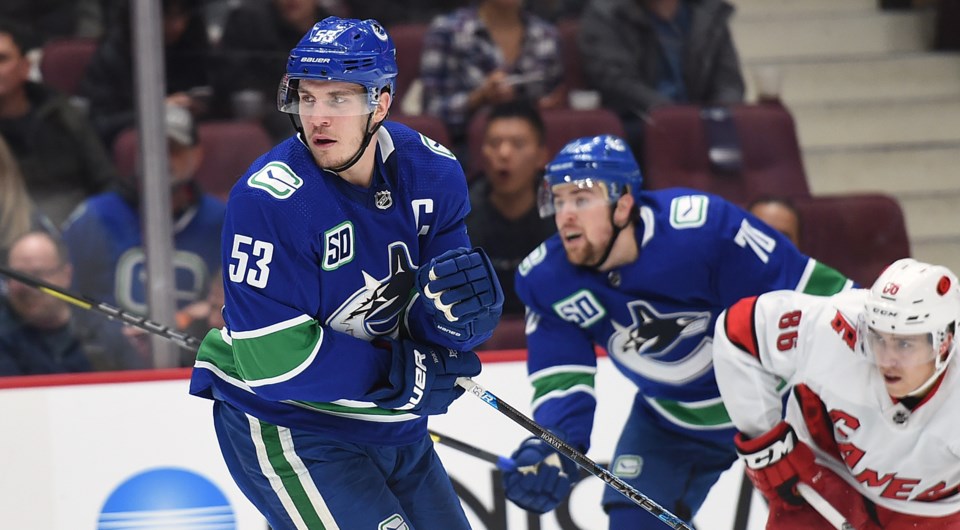J.T. Miller wasn’t supposed to play with Elias Pettersson; he was supposed to play with Bo Horvat.
That was the clear intention heading into the 2019-20 season. Canucks head coach Travis Green likes his duos — consistent two-man lines that stay together with a rotating third player — and the duos in the top-six were set to be Pettersson and Brock Boeser on the first line and Horvat and Miller on the second line.
Horvat and Miller were together for most of the preseason, with wingers Sven Baertschi, Nikolay Goldobin, and Tanner Pearson taking turns auditioning for the third slot. Miller gave Horvat a new dimension on his wing: a play-driving power forward that could match Horvat’s north-south game, win pucks along the boards, and provide some playmaking polish as well. Most of all, it would give Horvat some consistency after a rotating cast of linemates his previous season.
It didn’t work out that way.
Miller started the season with Horvat, but it quickly became clear that Micheal Ferland wasn’t working out on the top line. When Miller replaced Ferland on Pettersson’s left wing, the line took off and never looked back. They were legitimately one of the best lines in hockey all season.
Instead of Miller being the other half of his duo, Horvat spent the season with Tanner Pearson glued to his side. They had a rotating cast of wingers on the right side, including Jake Virtanen and Josh Leivo, but primarily played with Loui Eriksson.
That’s less than ideal — Eriksson may still be an effective two-way player, but he has no business being in the top-six. The trouble is that it’s awfully hard to find another winger for Horvat because he plays some of the most high-leverage minutes on the Canucks, starting a ton of shifts in the defensive zone and regularly matching up against the best forwards on the opposing team.
Toughest minutes on the team
Horvat took a ton of faceoffs for the Canucks this past season. He took 1,483 faceoffs, more than twice as many as J.T. Miller, who was second on the Canucks with 718. That was good for third in the NHL in total faceoffs behind Ryan O’Reilly and Jonathan Toews.
Horvat wasn’t second best when it comes to the defensive zone, however. At even strength, no centre in the NHL took more defensive zone faceoffs than Horvat. He took a whopping 451 — next best was O’Reilly at 396.
It was an even larger gap for the Canucks. Despite Beagle starting most of his shifts in the defensive zone, he took nearly 200 fewer defensive zone faceoffs than Horvat at even strength.
While Horvat got plenty of opportunities to start in the offensive zone as well, any winger that plays on his line has to be prepared to start a ton of shifts in the defensive zone. Then you combine that with Horvat’s match-up role against tough competition.
The players Horvat faced most frequently last season are a veritable All-Star Team. Connor McDavid, Leon Draisaitl, Johnny Gaudreau, John Tavares, Claude Giroux, Nathan MacKinnon, and Jack Eichel are all among the top-10 forwards faced by Horvat at 5-on-5.
In the playoffs, Horvat was the centre thrown to the wolves. Against the St. Louis Blues, he was matched up against the top line of Jaden Schwartz, Ryan O’Reilly, and David Perron. Versus the Vegas Golden Knights, it was Mark Stone, William Karlsson, and Max Pacioretty.
We can visualize the competition Horvat faced during the regular season using HockeyViz.com. The data visualization below shows how often each centre faced the forwards on the opposing team by ice time, which each time icing 12 forwards per game.
 2019-20 Canucks centres quality of competition via HockeyViz.com
2019-20 Canucks centres quality of competition via HockeyViz.comWith the red line representing the average amount of time an NHL player faces that level of competition, it’s clear that Horvat was tasked with shutting down first lines: he faced the top-three forwards by ice time on the opposing team far more than average and more than anyone else on the Canucks.
Jay Beagle faced opposing lines at around a league-average rate, while Brandon Sutter was a little below league average. In combination with Horvat, that provided a tiny bit of shelter to Pettersson — he still ended up playing against the opposing team’s best forward more than average — while significantly sheltering Adam Gaudette.
Who can play in a match-up role with Horvat?
Horvat plays difficult minutes and the challenge in finding a third linemate for Horvat and Pearson is clear. You can’t just stick a rookie prospect on the right wing with that duo unless they’re an exceptional prospect with a well-rounded defensive game. The Canucks do have one of those in the system — Vasili Podkolzin is a two-way beast — but he’s stuck in Russia until the end of the KHL season.
That’s why Eriksson spent so much time on Horvat’s line. He could handle the defensive zone starts and tough competition. The trouble is that Eriksson provided so little offensively.
It’s also why losing Josh Leivo to the Calgary Flames hurts the Canucks. Leivo signed a one-year deal with the Flames for $875,000, joining fellow former Canucks Jacob Markstrom, Chris Tanev, and Louis Domingue. The Canucks reportedly offered Leivo a similar deal.
Leivo was capable of playing in a match-up role with his strong possession game and ability to win puck battles. He provided flexibility on the wing, able to play on the third line or slot into the top-six when needed. The Canucks have to hope Jayce Hawryluk can fill a similar role as a utility forward.
The tough minutes played by the Horvat line are why Jake Virtanen is likely to slide all the way up to the first line with Pettersson and Miller, at least to start next season. His defensive game has too many flaws to be used in a match-up role with any regularity. That would bump Brock Boeser, whose two-way game took a significant step forward last season, down to Horvat’s line, where hopefully they can reignite their chemistry from Boeser’s rookie year.
Alternatively, maybe Miller will end up back with Horvat like originally intended. The trouble is that taking either Miller or Boeser away from Pettersson hurts their best line offensively.
If all else fails, Green might have to turn back to a veteran: Eriksson or even Brandon Sutter. The Canucks have to hope it doesn't come to that.




